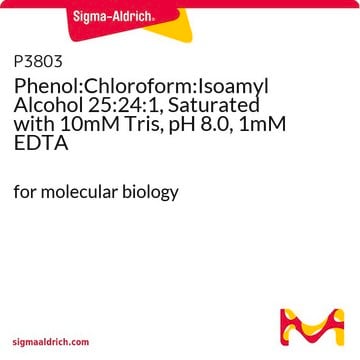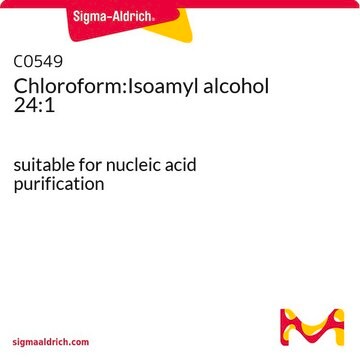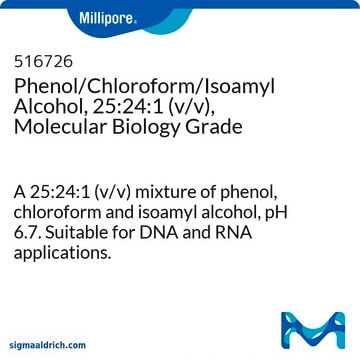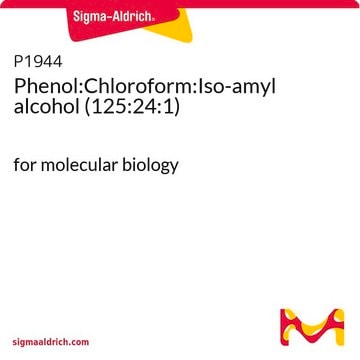77617
Phenol – chloroform – isoamyl alcohol mixture
BioUltra, for molecular biology, 25:24:1
About This Item
Recommended Products
grade
for molecular biology
Quality Level
product line
BioUltra
form
liquid
technique(s)
ChIP: suitable
DNA extraction: suitable
DNA purification: suitable
impurities
DNases, none detected
RNases, none detected
phosphatases, none detected
proteases, none detected
pH
7.2-8.3(H2O-phase, after extraction with H2O, 1:1)
density
1.28 g/mL at 20 °C
absorption
cut-off at 360 nm
suitability
suitable for molecular biology
application(s)
agriculture
storage temp.
2-8°C
SMILES string
ClC(Cl)Cl.CC(C)CCO.Oc1ccccc1
InChI
1S/C6H6O.C5H12O.CHCl3/c7-6-4-2-1-3-5-6;1-5(2)3-4-6;2-1(3)4/h1-5,7H;5-6H,3-4H2,1-2H3;1H
InChI key
ZYWFEOZQIUMEGL-UHFFFAOYSA-N
Looking for similar products? Visit Product Comparison Guide
Related Categories
General description
The applications of PCI-mixture are diverse, encompassing RNA isolation, where it efficiently extracts RNA from animal and plant tissues for downstream analyses like reverse transcription and gene expression studies. Further, PCI-mixture also proves instrumental in DNA extraction, enabling efficient recovery for various applications such as DNA minisatellite fingerprinting for genetic identification. As a general purification technique, PCI-mixture ensures high-quality preparations of both DNA and RNA for further research.
Application
Biochem/physiol Actions
Features and Benefits
- Versatile and adaptable for a wide variety of laboratory and research applications
- Free from DNase, RNase, NICKase and protease
Physical form
Other Notes
comparable product
related product
Signal Word
Danger
Hazard Statements
Precautionary Statements
Hazard Classifications
Acute Tox. 3 Inhalation - Acute Tox. 3 Oral - Acute Tox. 4 Dermal - Aquatic Chronic 2 - Carc. 2 - Eye Dam. 1 - Muta. 2 - Repr. 2 - Skin Corr. 1B - STOT RE 1 Oral - STOT RE 2 - STOT SE 3
Target Organs
Central nervous system, Liver,Kidney, Nervous system,Kidney,Liver,Skin
Storage Class Code
6.1A - Combustible acute toxic Cat. 1 and 2 / very toxic hazardous materials
WGK
WGK 3
Flash Point(F)
174.2 °F
Flash Point(C)
79 °C
Personal Protective Equipment
Regulatory Listings
Regulatory Listings are mainly provided for chemical products. Only limited information can be provided here for non-chemical products. No entry means none of the components are listed. It is the user’s obligation to ensure the safe and legal use of the product.
PDSCL
Deleterious substance
PRTR
Class I Designated Chemical Substances
FSL
Group 4: Flammable liquids
Type 3 petroleums
Hazardous rank III
Water insoluble liquid
ISHL Indicated Name
Substances Subject to be Indicated Names
ISHL Notified Names
Substances Subject to be Notified Names
JAN Code
77617-100ML:4548173179759
77617-BULK:
77617-6X100ML:4548173273174
77617-VAR:
77617-6X500ML:4548173273181
77617-INTR:
77617-500ML:4548173179766
Certificates of Analysis (COA)
Search for Certificates of Analysis (COA) by entering the products Lot/Batch Number. Lot and Batch Numbers can be found on a product’s label following the words ‘Lot’ or ‘Batch’.
Already Own This Product?
Find documentation for the products that you have recently purchased in the Document Library.
Customers Also Viewed
Our team of scientists has experience in all areas of research including Life Science, Material Science, Chemical Synthesis, Chromatography, Analytical and many others.
Contact Technical Service













